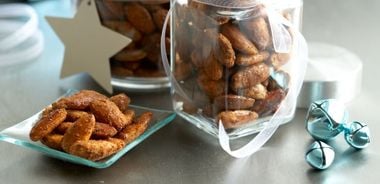Sweet and Spicy Nuts

Fellow professional home economist, Barb Holland, gave me a jar of these for Christmas last year, and they were such a huge hit that I had to hide them from my family so I could at least have a couple.
They’re sweet with a bit of heat and, as Barb says, “can become addictive.” If you want more heat, add more cayenne. She used almonds in her original recipe but walnuts work well too.
1 egg white
2 cups (500 ml) whole natural almonds or walnuts
1/4 cup (60 mL) brown sugar
1 tsp (5 mL) ground cumin
1/2 to 1 tsp (2 to 5 mL) cayenne
1/4 tsp (1 mL) salt
Preheat oven to 325 F (160 C). In a bowl, lightly beat egg white. Add nuts and stir until evenly moistened. Combine brown sugar, cumin, cayenne, and salt; sprinkle over nuts and toss well to coat evenly.
Spread nuts on natural parchment paper-lined, rimmed baking sheet. Bake for 30 to 45 minutes, stirring every 10 minutes to separate nuts, until coating is crisp and nuts are fragrant.
Pack into small glass jars with tightly fitting lids.
Makes 2 cups (500 mL).
Each 1/4 cup (60 mL) serving contains: 213 calories; 5 g protein; 18 g total fat (0 g sat. fat, 0 g trans fat); 4 g carbohydrates; 1.9 g fibre; 7 mg sodium.
source: "Edible Christmas Gifts", alive #314, December 2008




